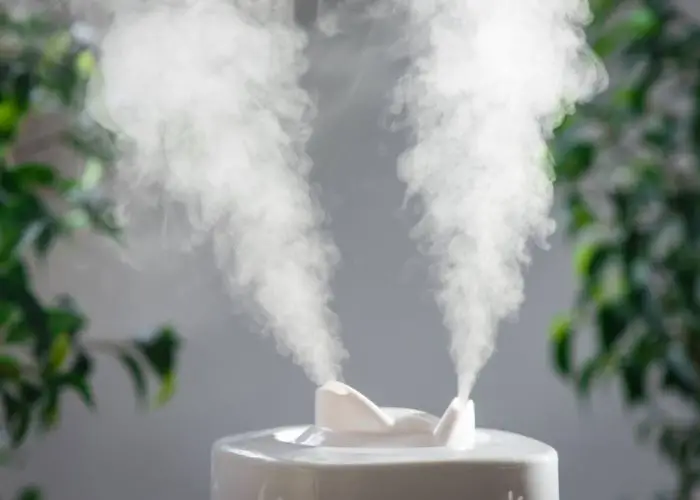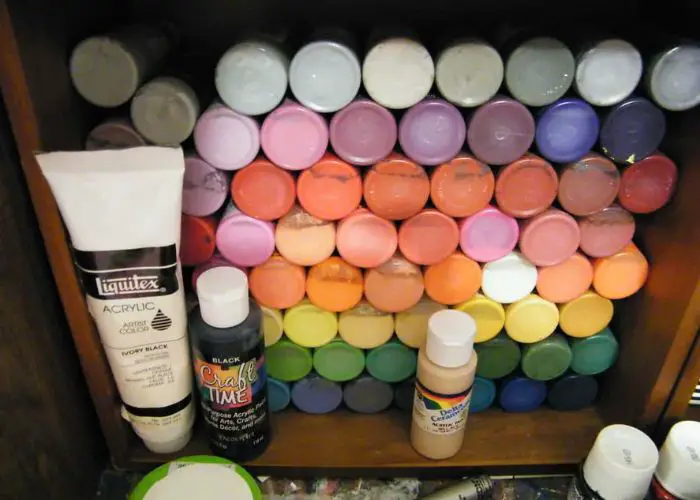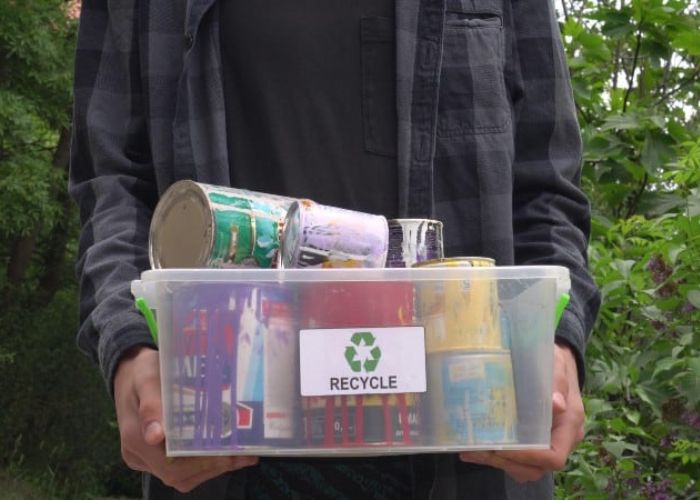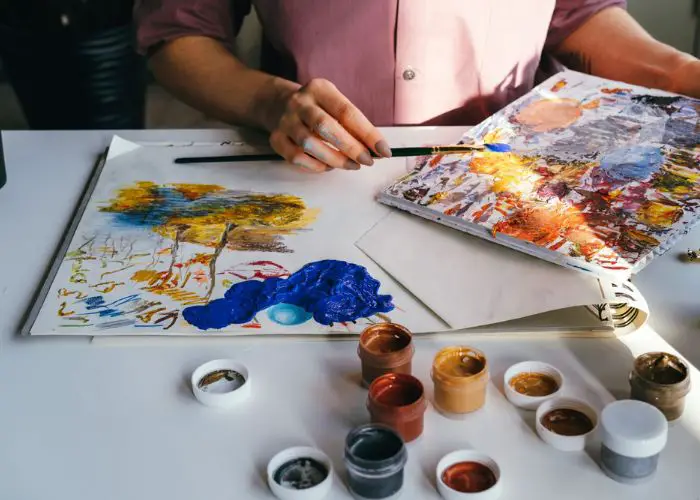As an artist, it’s important to know how to keep acrylic paint wet. If you don’t take the necessary precautions, your paint can dry out and become unusable.
This blog post will discuss how to prevent your paint from drying out, how to reuse dried acrylic paint, and how to reactivate acrylic paint.
We’ll also provide some tips on what to do with dried acrylic paint and how to remove it from plastic palettes.
Follow these tips, and you’ll be able to keep your paints wet for longer.
How to Keep Acrylic Paint Wet
You’ll need to take some precautions to keep your acrylic paint wet. First, seal the opening of the acrylic paint tube with plastic wrap. Second, store your acrylic paints in a cool, dark place. Third, don’t leave your paintbrushes in the paint for too long. Fourth, try to use a humidifier in your painting area.
How to Keep Acrylic Paints Wet
The following are ways how to keep your acrylic paint from drying out:
1. Use a humidifier in your room/studio

Any artist who has worked with acrylic paint knows that one of the biggest challenges is keeping the paint wet.
Once it dries, it can be extremely difficult to re-wet and continue working. This is where a humidifier comes in.
By adding moisture to the air, a humidifier can help to keep your paint from drying out.
In addition, it can also reduce static electricity, which can be a problem when working with acrylics.
As a result, a humidifier can be a valuable tool for any artist who works with acrylic paint.
We recommend the AquaOasis™ Cool Mist Humidifier as it’s the most effective in the market.
2. Store your paints in an airtight container when not in use
The best way to store acrylic paint is in an airtight container. This will keep the paint from drying out and prevent it from becoming contaminated by dust or other particles.
Make sure to label the container with the date so you can use the oldest paint first. The Paint storage containers for leftover paint cans ensure that air does not enter and dry the paint.
3. Keep your palette covered when not in use
If you’re using a plastic or glass palette, keep it covered when you’re not painting.
This will help to keep the paint from drying out and prevent dust from settling on the surface. You can buy special palette covers or use a sheet of plastic wrap.
4. Use a wet brush to moisten dry paint
If your paint has started to dry out, you can try using a wet brush to moisten it. Dip the brush in water and then gently touch the bristles to the paint’s surface.
This should help to re-wet the paint and make it workable again.
5. Add a wetting agent to your paints
Wetting agents are substances that can be added to paint to help keep it wet. They work by reducing the surface tension of the water, preventing it from evaporating as quickly.
You can find wetting agents at most art supply stores. We recommend using a wetting agent sparingly, as too much can make the paint difficult to work with.
The good thing is that you can even use it on acrylic oil paint. Golden Acrylic Wetting Agent is our recommended product.
6. Cover your palette with a damp cloth or paper towel when not painting
Another way to keep your paint from drying out is to cover your palette with a damp cloth or paper towel when you’re not using it.
This will help keep moisture in the air and prevent paint from drying out.
Related Read: Can You Use a Damp Paint Brush?
7. Use interactive acrylics with a Masterson palette
Masterson makes a special type of palette that is designed to keep acrylic paint wet.
The palette has a built-in reservoir that can be filled with water, and the surface is coated with a special material that helps to retain moisture.
If you use interactive acrylics, we recommend trying out a Masterson Star Wet palette.
8. Plastic pots and tin foil
If you’re looking for a cheap and easy way to keep your paint wet, try using plastic pots and tin foil.
Put your paint in the pot, and then cover it with a layer of tin foil. This will help keep the acrylic paints moist and prevent the paint from drying.
9. Use slow-drying acrylic paints
Slow-drying acrylic paints are formulated to dry more slowly than regular acrylics. This gives you more time to work with the paint before it starts to dry out.
You can find slow-drying acrylics at most art supply stores. A good example of slow-drying acrylics is Golden Open Acrylics.
10. Add a retarder to your paint
A retarder is a substance that can be added to paint to slow down the drying time.
Retarders are available at most art supply stores, and we recommend using Golden 0003580-5 Acrylic Retarder. Too much retarder can make the paint difficult to work with.
11. Work in a well-ventilated area
When working with acrylics, it’s important to work in a well-ventilated area. This will help to keep the fumes from the paint from becoming overwhelming.
In addition, it will also help to prevent the paint from drying out too quickly.
12. Use Stay Wet Palette
Wet palettes are specially designed to keep acrylic paint wet.
They have a built-in reservoir that can be filled with water, and the surface is coated with a special material that helps to retain moisture.
Wet palettes are an excellent way to keep your paint from drying out, and they’re also great for mixing colors. You can find stay wet palettes at most art supply stores.
13. Use nonabsorbent palettes
Nonabsorbent palettes are made of materials that don’t absorb moisture. This helps to keep the paint from drying out, and it also makes cleanup a breeze.
You can find nonabsorbent palettes at most art supply stores. A good example of a nonabsorbent palette is the Masterson Super Pro Palette.
14. Use an airtight sealant on your painting
Once you’ve finished your acrylic painting, you can seal it with an airtight sealant.
This will help to keep the paint from drying out and prevent it from fading over time.
You can find airtight sealants at most art supply stores.
15. Store your paint in a cool, dark place

Once you’ve finished using your paint, it’s important to store it in a cool, dark place. This will help to prevent the paint from drying out and keep it from fading.
16. Putting wet paper towels under wax paper
If you’re working with a small amount of paint, you can keep it from drying out by putting wet paper towels under wax paper.
The moisture from the paper towels will help keep the paint moist, and the wax paper will prevent the paint from drying.
17. Keep your paint in a fridge
You can also keep your acrylic paint from drying out by storing it in a fridge. This will help to keep the paint from drying out and prevent it from fading.
Just be sure to store your paint in an airtight container so that it doesn’t dry out.
How To Store Acrylic Paint in a Fridge
You’ll need to find an airtight container to store acrylic paint in a fridge. Once you’ve found a suitable container, add your paint and then seal it tightly.
Then, store the container in the fridge. This will help to keep the paint from drying out and prevent it from fading.
Just be sure to bring the paint to room temperature before using it so that it doesn’t freeze.
How to Reuse Dried Acrylic Paint
Is acrylic paint water based? Yes, acrylic paint is a water-based paint, which means that it dries quickly.
This can be an advantage when you’re trying to complete a project in a short amount of time.
But it also means that you have to be careful not to let the paint dry out before you’re finished using it.
If you find yourself in this situation, don’t despair—there are several ways to reuse dried acrylic paint.
One option is adding water to the dried paint and mixing it until you have a liquid consistency. You can then use the paint as normal.
Another option is to scrape off the dried paint and add it directly to your palette or canvas—this can create interesting textural effects.
Finally, if the dry paint is difficult to remove, you can try soaking it in warm water for a few minutes before gently scrubbing it off.
How Long Does Acrylic Paint Last?
Or, simply put – does acrylic paint go bad? Well, it depends on how you store it. If you store it properly, it can last for years.
But if you don’t store it properly, it will start to degrade and become unusable within a few months.
Acrylic paint is made from pigments suspended in a polymer emulsion. The pigments give the paint its color.
While the polymer emulsion helps to bind the pigments together and gives the paint its durability.
One of the most important factors in determining how long your acrylic paint will last is the type of storage containers you use.
Glass or plastic containers with tight-fitting lids are ideal, as they will protect the paint from oxygen and humidity.
If you must use paper or cardboard containers, seal them tightly to prevent the paint from drying out.
Another important factor is temperature. Acrylic paint should be stored at room temperature; extreme heat or cold can cause the paint to degrade.
How to Reactivate Acrylic Paint
If your paint has dried out, you can try to reactivate it by adding water and mixing it until you have a liquid consistency again.
You can also try scraping off the dried paint and adding it directly to your palette or canvas, creating interesting textural effects.
Finally, if the dry paint is difficult to remove, you can try soaking it in warm water for a few minutes before gently scrubbing it off.
How to Remove Dried Acrylic Paint from Plastic Palette
If you have dried acrylic paint on your plastic palette, you can try to remove it with warm soapy water.
First, soak the palette in soapy water for a few minutes. Then, use a soft brush or cloth to scrub the dried paint off gently.
If the paint is still stubborn, you can try using a razor blade to scrape it off. Finally, rinse the palette with clean water and dry it off.
How to Dispose of Acrylic Paint

Acrylic paint is non-toxic and can be disposed of in regular trash. However, it is not considered environmentally friendly because it is made from petroleum products.
If you’re looking for a more eco-friendly option, you can try to recycle the paint.
You can also try to donate it to schools or community organizations. Here’s more on disposing of acrylic paint safely.
How to Keep Acrylic Paint Wet Overnight
There are several ways to keep acrylic paint wet overnight so you can continue working on your project the next day.
One option is to seal the paint palette with cling wrap or a damp cloth. This will create a barrier between the air and the paint, preventing it from drying out.
Another option is adding a retarder to the paint, which will slow the drying process.
Finally, you can work in a humid environment, such as a bathroom with the shower running, to prevent the paint from drying out too quickly.
How to Keep Acrylic Paint Wet on Canvas
If you’re working on a canvas, you can try to keep the paint wet by using a spray bottle filled with water.
Then, spritz the canvas lightly every few minutes, and cover it with a damp cloth when you’re not working.
You can also try painting in layers so that the top layer is always wet while you work on the bottom layer.
Finally, if you’re working in a dry environment, you can try using a humidifier to keep the air moist.
Read more on How to Protect your Acrylic Painting on Canvas.
How to Make Acrylic Paint Dry Faster
One common method is using a hairdryer in a low or cool setting. Place the hairdryer about 12 inches away from the painting and move it around until the painting is dry.
Another method is to fan the painting until it’s dry. You can also try placing the painting in a well-ventilated area or in front of a fan.
Finally, if you’re in a hurry, you can use an acrylic paint accelerator. These products are available at most art supply stores and can help to speed up the drying process.
However, follow the manufacturer’s instructions carefully, as some accelerators can cause the paint to become tacky if used in too high of a concentration.
When using any of these methods, keep an eye on the painting so that it doesn’t dry too quickly and develop cracks. Here are more tips on how to dry acrylic paint faster.
FAQs
How to make acrylic paint dry slower
One option is to add a retarder to your paint. This slows down the drying process and gives you more time to work with the paint. Another option is to thin your paint with water. This will also help to prevent the paint from drying too quickly. Finally, if you’re working in a humid environment, this can help to keep the paint from drying too fast. Alternatively, opt for a slow drying acrylic paint.
How do you revive completely dried acrylic paint?
If your paint has dried out, you can try to reactivate it by adding water and mixing it until you have a liquid consistency. You can also try scraping off the dried paint and adding it directly to your palette or canvas, creating interesting textural effects. Here is more on how to revive acrylic paint.
How do you use hardened acrylic paint?
You can use hardened acrylic paint in one of two ways. The first way is to scrape it off the surface and use it as a dry pigment. This can be used to add color to other mediums or create a textured background. The second way is to re-wet the paint and use it like regular acrylic paint. To do this, you’ll need to add a drop or two of water to the paint and mix it well. Once the paint is re-wet, you can use it like normal.
Can acrylic paint be reused?
Yes, acrylic paint can be reused. If the paint has dried out, you can re-wet it and use it like regular acrylic paint. To do this, you’ll need to add a drop or two of water to the paint and mix it well. Once the paint is re-wet, you can use it like normal.
How to keep paint from drying out
You can do a few things to keep your paint from drying out. First, make sure you use an airtight container to store your paint. This will help to keep the air and moisture out. Second, add a drop or two of water to your paint before putting the lid on. This will help to keep the paint from drying out. Finally, if you’re not using your paint immediately, put it in the fridge. This will help to keep the paint from drying out and extend its life.
Conclusion
So there you have it! Here are a few simple tips on keeping your acrylic paint wet for longer periods.
By following these steps, you’ll be able to extend the life of your paint and get more use out of each tube.
Do you have any other tips on how to keep acrylic paint wet? Could you share them in the comments below?
Happy painting.











Leave a Reply